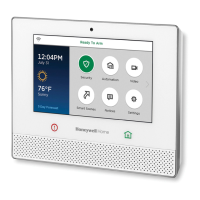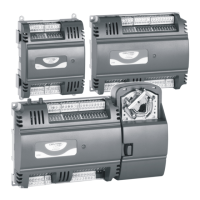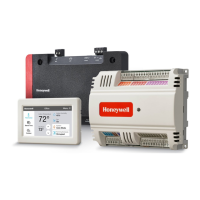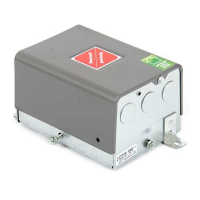Lyric Controller Installation and Reference Guide
- 28 -
Testing the System
Testing the SystemTesting the System
Testing the System
TO THE INSTALLER
TO THE INSTALLERTO THE INSTALLER
TO THE INSTALLER
Regular maintenance and inspection (at least annually) by the installer and frequent testing by the user are
vital to continuous satisfactory operation of any alarm system.
The installer should assume the responsibility of developing and offering a regular maintenance program to
the user as well as acquainting the user with the proper operation and limitations of the alarm system and its
component parts. Recommendations must be included for a specific program of frequent testing (at least
weekly) to ensure the system’s proper operation at all times.
Test Mode
Test ModeTest Mode
Test Modes
ss
s
The “Test” button provides access to the following functions and test modes:
Option
OptionOption
Option Function
FunctionFunction
Function
Walk Test Refer to the User Manual for additional information
RF Sniffer Test Refer to the Programming Guide (p/n 800-18077) for additional information.
Go-No-Go Test Refer to the Programming Guide (p/n 800-18077) for additional information.
Diagnostics Provides access to the Reboot Feature. Refer to the paragraph in this section for additional
information regarding this feature.
Zone Discovery Provides access to the Zone Discovery mode. Refer to the paragraph in this section for
additional information regarding the Zone Discovery feature.
Install Cell
User feature that allow the Master User to install or replace a Communications Module.
Refer to the User Guide (p/n 800-18078) for additional information.
System
Information
System Information is displayed. Select OK to return to the previous screen.
Install Backup
Battery
User feature that allow the Master User to replace the backup battery. Refer to the User
Guide (p/n 800-18078) for additional information.
Testing the System
Testing the SystemTesting the System
Testing the System
After installation is completed, the security system should be carefully tested, as follows:
1. With the system in the disarmed state, check that all zones are intact. If the “ready” LED or “Home” button
is not lit, select the Zones icon to display the faulted zone(s). If necessary, restore faulted zone(s) so that
the “ready” LED or “Home” button lights. Fault and restore every sensor individually to assure that it is
being monitored by the system.
Armed System Test
Armed System TestArmed System Test
Armed System Test
Alarm messages will be sent to the Central Station during the following tests 1 and 2.
Notify the
Notify theNotify the
Notify the
Central
Central Central
Central
Station
Station Station
Station in advance that tests will be in progress.
in advance that tests will be in progress.in advance that tests will be in progress.
in advance that tests will be in progress.
1. Arm the system and fault one or more zones. After 15 seconds (if optional Alarm Report Delay is selected),
silence alarm sounder(s) by disarming the system. Check entry/exit delay zones.
2. Check the keypad-initiated alarms that are in the system by selecting the Panic key. If the system has been
programmed for audible emergency, the keypad will emit a steady alarm sound, and “ALARM” and zone
number will be displayed. Silence the alarm by entering the Security Code.
If the system has been programmed for silent emergency, there will be no audible alarms or displays, but a
report will be sent to the Central Station.
3. Notify the Central Station when all tests are finished, and verify results with them.
4. To test the wireless part of the system and the RF receiver, perform the two additional tests described in
the Programming Guide (p/n 800-18077): Sniffer mode and Go/No Go Test.
Note:
Note: Note:
Note:
System Test mode and Go/No Go Test will be automatically terminated after 3-1/2 to 4 hours if the
installer or user does not manually terminate it. This ensures that fire and panic zones will not remain
disabled. However, Sniffer mode does not automatically expire. You must manually exit Sniffer mode by
selecting the Home key and entering the Master Code, to return to normal operation. During the final 5
minutes the system will emit double beeps indicating that the end of Test mode is nearing.

